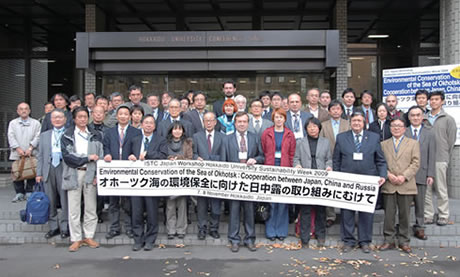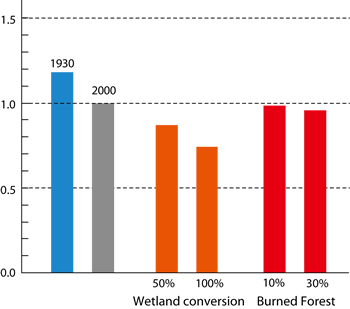Human Activities in Northeastern Asia and Their Impact on Biological Productivity in North Pacific Ocean
How do continental forests and wetlands affect life in the sea? Adapting the traditional Japanese concept uotsukirin, or “fish-breeding forest”, this project investigated the ecological linkages between the Amur River basin and primary marine productivity in the Sea of Okhotsk and Oyashio region of the northern North Pacific Ocean. In particular, the project documented how dissolved iron from the Amur River supports ocean primary production and how this iron discharge is affected by human activity in the Amur River basin. Finally, by studying the underlying causes behind the land-use changes in the basin, the project proposed how this continental-scale terrestrial-marine linkage-the giant fish-breeding forest-can be sustained.
Achievement of the project
The Sea of Okhotsk and the neighboring Oyashio current region compose one of the richest marine environments in the world. This project investigated the source of this productivity. Iron is an essential element for phytoplankton, but iron's insolubility usually limits its availability in open water. In the Sea of Okhotsk region, however, we hypothesized that thermohaline circulation caused by sea ice production would increase the amount of iron available to phytoplankton. We supposed that the original source of this iron was upstream, in the forests and wetlands of the Amur River basin.
In the last five years, our intensive field activities in the Amur River basin and the Sea of Okhotsk/Oyashio region validated these initial ideas. We found that 40% of the annual phytoplankton productivity in the Oyashio region depends on iron from the Amur River; the remaining 60% depends on iron recycled through a microbial loop.
In the Amur River basin, the highest concentration of iron was recorded in the wetlands extending through the middle reaches of the basin. In the latter half of the 20th century, however, this wetland has often been converted into upland and paddy fields. In order to determine the effect of this land conversion on primary productivity in the Sea of Okhotsk, we reconstructed basin-scale land-use maps for 1930 and 2000 and developed a hydrological model designed to compare the potential iron flux from the Amur River in each period. The results suggest that iron flux in the 1930 was 20% higher than in 2000, and will decrease further as wetland conversion or forest burning continues (Fig. 1). The project results motivated us to establish an epistemic community, the Amur-Okhotsk Consortium, to discuss sustainable use of the Amur-Okhotsk ecosystem.
 |  |
| Photo The Amur-Okhotsk Consortium was established for the futurability of the Amur-Okhotsk Ecosystem including the giant fish-breeding forest | Fig 1 Simulated results of land cover conversion in the Amur River Basin on iron flux Iron flux in 2000 (■grey bar) is compared to that estimated in 1930 (■blue bar) and under several land change scenarios. ■Orange bars show potential decrease with 50% or 100% decrease in wetland area; ■red bars show potential decrease with 10% or 30% increase in forest burning. |

